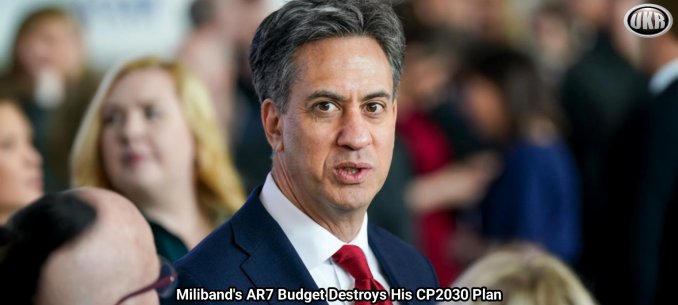
The AR7 Budget for offshore wind will not deliver CP2030 but will impoverish us all.
DAVID TURVER
Introduction
Yesterday, the Department of Energy Security and Net Zero (DESNZ), led by Ed Miliband, released the budget for the offshore wind part of the current Allocation Round 7 (AR7) auction of renewables capacity.
There are changes to both the methodology and the base year of calculations making comparisons to prior auctions difficult. However, we can see how the maximum available capacity will impact our bills and how it compares to Miliband’s own Clean Power 2030 (CP2030) plan.
AR7 Budget
The headline is that the AR7 budget for offshore wind is £1,080m per year, split £900m for conventional fixed bottom and £180m for floating offshore wind as shown in Figure A.

This year, the budget is expressed in 2024 prices, whereas previous budgets were expressed in 2012 prices. There have also been other changes to the budget methodology meaning that direct comparison with other years is misleading.
However in broad terms, if they manage to attract enough bids and the strike prices and reference prices they assume are accurate, then DESNZ expects the offshore wind auction to add £1,080m to our bills in 2031/32. This compares to the total £2,242m in CfD subsidies paid out in 2024/25.
What Capacity Will the Budget Deliver?
The budget impact calculation is quite complex and is set out in the accompanying contract allocation framework.
The Budget Impact is defined as the difference between the strike price and the reference price multiplied by the nameplate capacity and the load factor and the number of hours in a year. The budget impact is slightly reduced by another the Transmission Loss multiplier, set at 0.91%.
Using this formula, we can back calculate the maximum capacity to be auctioned if all bids are at the Administrative Strike Price.
Figure B shows the result of that calculation for fixed bottom offshore wind.

In the final delivery year of 2030/31, DESNZ expects the market reference price of fixed bottom offshore wind to fall to £33.43/MWh, meaning they expect it to receive more than twice as much – £79.57/MWh – as subsidy. Working through the arithmetic, each GW of nominal capacity would expect to receive £301m per year, so the budget will stretch to just under 3GW.
Looking at it another way, the expected capacity increases if the strike price of the contracts awarded is lower than the price on offer as shown in Figure C.

If the strike price falls to £90/MWh (2024 prices) then the awarded capacity could be up to 4.2GW. However, that seems unlikely because Hornsea 4 was cancelled as uneconomic with a strike price of ~£82/MWh, albeit with a 15-year contract. If the strike price settles at £100/MWh, the maximum volume will be 3.6GW.
The expected reference price indicates just how much they expect new offshore wind capacity to cannibalise existing projects, meaning the value of their output falls significantly. However, they also expect baseload reference prices fall to just £43.44/MWh in that year. This means they either expect gas prices to fall significantly or that either Reform or the Tories get into power and remove carbon taxes from gas-fired generation. We might reasonably ask why they are offering contracts for intermittent power some 2.6 times more expensive than the expected price of reliable baseload power.
Figure D shows the similar calculation for Floating Offshore Wind.

Working through the arithmetic, the £180m annual budget will procure about 0.2GW of floating offshore wind capacity. The strike price on offer is some 6.2 times their expected baseload price.
Impact on CP2030
The total capacity on expected is just 3.2GW at the offer price, spread over several delivery years out to 2030/31. However, back in August, Offshore Energies UK warned that at least 8.4GW would need to be approved in AR7 to meet the CP2030 target. NESO’s CP2030 plan, covered here, called for between 4.1GW and 5.1GW of offshore wind to be installed every year from 2024 to 2030. Energy Trends data (T6.1) shows less than 1.2GW was installed in 2024. Even if the strike prices of awarded contracts come in lower than the offer, there is no chance of procuring sufficient capacity.
Last year’s AR6 delivered 3.4GW of new fixed bottom offshore wind capacity and a further 400MW of floating offshore wind. However, he flagship Hornsea 4 project, supposed to deliver 2.4GW of that capacity was cancelled by Orsted earlier this year. Moreover, the economics of the projects still under construction from AR3 and AR4 look decidedly shaky too.
Conclusions
There is simply no chance that Miliband is going to achieve his CP2030 plan. Nowhere near enough capacity is going to be contracted in AR7 to achieve his target.
However, he is pressing on with AR7 and offering ridiculous prices to developers in new index-linked contracts with extended 20-year terms. There is no chance he will achieve his plan, but every chance he will bankrupt the nation in the process.
AR7 needs to be stopped. Now.
This Substack now has well over 4,700 subscribers and is growing fast. If you enjoyed this article, please share it with your family, friends and colleagues and sign up to receive more content.
This article (Miliband’s AR7 Budget Destroys His CP2030 Plan) was created and published by David Turver and is republished here under “Fair Use”

••••
The Liberty Beacon Project is now expanding at a near exponential rate, and for this we are grateful and excited! But we must also be practical. For 7 years we have not asked for any donations, and have built this project with our own funds as we grew. We are now experiencing ever increasing growing pains due to the large number of websites and projects we represent. So we have just installed donation buttons on our websites and ask that you consider this when you visit them. Nothing is too small. We thank you for all your support and your considerations … (TLB)
••••
Comment Policy: As a privately owned web site, we reserve the right to remove comments that contain spam, advertising, vulgarity, threats of violence, racism, or personal/abusive attacks on other users. This also applies to trolling, the use of more than one alias, or just intentional mischief. Enforcement of this policy is at the discretion of this websites administrators. Repeat offenders may be blocked or permanently banned without prior warning.
••••
Disclaimer: TLB websites contain copyrighted material the use of which has not always been specifically authorized by the copyright owner. We are making such material available to our readers under the provisions of “fair use” in an effort to advance a better understanding of political, health, economic and social issues. The material on this site is distributed without profit to those who have expressed a prior interest in receiving it for research and educational purposes. If you wish to use copyrighted material for purposes other than “fair use” you must request permission from the copyright owner.
••••
Disclaimer: The information and opinions shared are for informational purposes only including, but not limited to, text, graphics, images and other material are not intended as medical advice or instruction. Nothing mentioned is intended to be a substitute for professional medical advice, diagnosis or treatment.
Disclaimer: The views and opinions expressed in this article are those of the author and do not necessarily reflect the official policy or position of The Liberty Beacon Project.






Leave a Reply